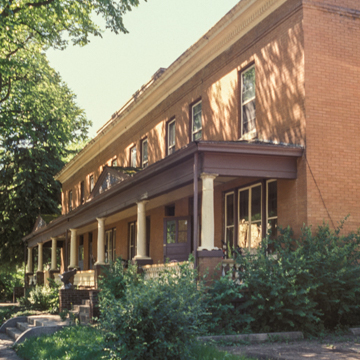Most of Grand Forks historic southside houses are single-family residences, but a collection of multiple-family dwellings and apartments, constructed between 1903 and 1930, is found toward the north end of the residential district, nearer the commercial zone. The Dinnie Apartments were constructed by brothers John and James Dinnie, one of the largest contractor partnerships in the state of North Dakota. These unpretentious brick row houses are fronted by a continuous porch carried on classical columns with shallow pediments marking the entrances. Grand Forks supported two major brickyards, which supplied most of the brick used in the city’s buildings from 1879 to 1930. Following John Bartholemew, John Dinnie opened the city’s second brickyard in the 1880s. The Dinnie Apartments were financed and speculatively built by Dinnie Brothers for working-class families.
You are here
Dinnie Apartments and Row Houses
If SAH Archipedia has been useful to you, please consider supporting it.
SAH Archipedia tells the story of the United States through its buildings, landscapes, and cities. This freely available resource empowers the public with authoritative knowledge that deepens their understanding and appreciation of the built environment. But the Society of Architectural Historians, which created SAH Archipedia with University of Virginia Press, needs your support to maintain the high-caliber research, writing, photography, cartography, editing, design, and programming that make SAH Archipedia a trusted online resource available to all who value the history of place, heritage tourism, and learning.















